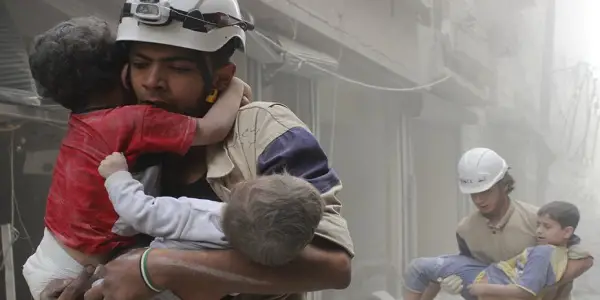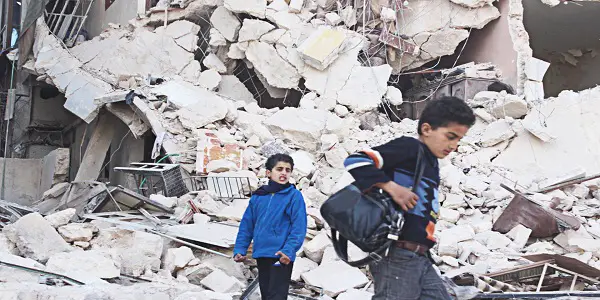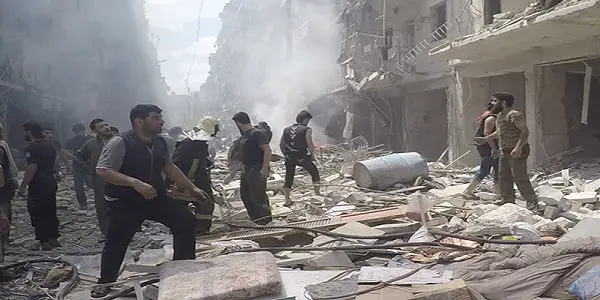CRIES FROM SYRIA: Hope Amidst The Wreckage

Daniel is a writer based in Sheffield, UK. He has…
The conflict in Syria is one which defies simple distinctions, and one must be cognizant of the competing narratives at play in its reporting. In 2011 it seemed like the regime of Bashir al-Assad would be the next to fall victim to the Arab Spring. What purportedly began as an outpouring of rage against the Assad regime’s alleged torture of teenage dissenters has mutated into a deadly and complex conflict which increasingly feels like a proxy for a larger geopolitical schism. There are uneasy echoes of the Spanish Civil War.
Syria is becoming the defining conflict of our confusing epoch. There are flickers of hope like the all-female Kurdish YPJ units fighting ISIS in Rojava, but the prevailing picture is one of division, brutality and escalating atrocity between the regime, rebel militias and radical fundamentalists. What is clear is that the civilian population is suffering. With the ‘refugee crisis’ returning to the headlines following the UK’s refusal to accept child refugees and the US’s travel ban, the need for clarification has never been more pressing.

The war featured prominently at this year’s Sundance, with Cries from Syria premiering alongside City of Ghosts, Last Men in Aleppo and Mare Nostrum. For director Evgeny Afineevsky, the follow-up to his Oscar and Emmy nominated Winter on Fire: Ukraine’s Fight for Freedom was inspired by a single image. The image was of Alan Kurdi, a three-year-old whose body washed up on a Turkish beach when the inflatable raft on which he and fifteen other refugees were fleeing Syria capsized in the Mediterranean Sea.
An Emotive Pitch
The humanity of the conflict was brought home in that image, and Afineevsky into fashioning a ‘comprehensive account’ of life for a ‘lost generation’. Cries from Syria places a heavy emphasis on children; as Afineevsky points out, ‘kids and mothers are an essential part of this war’. Afineevsky drew on hundreds of hours of first-person footage and testimonials from child protestors, revolution leaders, human rights defenders, ordinary citizens and high-ranking generals who have defected. It is a brutal variant on crowd-sourced projects like India in a Day and ground-level accounts like Ambulance.
For those seeking a sober explication of this most complex conflict, Cries from Syria is not that film. Indeed, Afineevsky seems to shy away from the broader implications of Syria’s place as a benighted pawn in the Great Game. There is a scene-setting info-dump – narrated by Helen Mirren – which traces events from the 1963 coup which brought the Ba’ath Party to power, but the film’s focus is more micro than macro. The proximity to the brutality is unprecedented. Drone footage captures a blasted landscape, scorched grey and swathed in ‘the dust of destruction’; the aftermath of events like the chemical attack on Ghouta is seen at close quarters; and the theocratic nihilism of ISIS is shown in grisly detail.

The film’s most laudable service is its elucidation of the ‘refugee crisis’. The film was spurred by the death of a refugee, and Afineevsky shows the perilous path out of a life ravaged by war. The footage of conditions in refugee camps places our callous refusal in an even more shameful light. ‘Where is the humanity?’, as one child asks after detailing his dehumanizing treatment in Hungary. For all its subjectivity, Cries from Syria is a tribute to the spirit of Syria’s children. These children are truly heroic, inured to the logic of war but retaining their humanity and compassion in spite of everything they’ve seen and experienced.
Eschewing Ambiguity
Cries from Syria comes squarely from the perspective of those standing in opposition to Assad, the footage is framed by talking heads from figures like activist Kholoud Helmi, footballer-turned-rebel Abdul Baset Al-Sarout and former Syrian Air Force Colonel Riad Al-Asaad. Its ideology is more one of omission, and one has to read between these absences. There is condemnation of Russian bombing in 2015, but no mention of the US-led ‘intervention’ a year earlier. The footage presents a powerful denunciation of the Assad regime’s attacks on civilians, but like the conflict itself, nothing is clear cut.
Martin Tillman‘s score has a lightweight quality which feels utterly at odds with the film’s ominous tone, his airy piano patterns are overwhelmed by the severity of the images they accompany; and the less said about the song Cher contributes to the closing credits the better. Editor Aaron I. Butler seeks to fashion a narrative arc by imposing a chapter structure; but Syria is a morass of conflicting and overlapping agendas which is too multi-faceted to be encompassed by such a neat, linear progression. This attempt to impose order on chaos is exemplified in the film’s presentation of the Free Syrian Army; in particular its Faustian pact with Jabhat Al-Nusra, which signalled the entry of Al-Qaeda into Syria.

This section in particular feels like a missed opportunity. Afineevksy had the chance to insert some nuance here; to make a point about realpolitik; to explore the uneasy alliances which must be forged in defeating a common enemy, and the very real possibility of losing one’s identity in the process. But this view doesn’t fit into Afineevsky‘s characterisation of the FSA as the only honourable player in this conflict. Afineevsky chooses not to step beyond this narrative, and in so doing betrays his partiality in covering, or not covering, the slow disintegration of the FSA into internecine struggle and operational paralysis.
The Verdict
In witnessing the relentless horrors Cries from Syria assembles, one goes through a process akin to grief: shock becomes anger becomes enervation. It is a visceral experience which grinds one down into a state of dazed incomprehension. Its barrage is often difficult to watch, but it must be witnessed. We see a country torn to its foundations; and for all Afineevsky‘s unwillingness to situate Assad and his opponents in a broader geostrategic perspective, the pain is real, the malnutrition is real, the torture is real, the barbarity is real.
Though Cries from Syria seeks to present itself as an essentially humanist story divorced from partisan concerns, it cannot entirely distance itself from the urgency of a world war, which Syria is increasingly becoming. There is an implicit plea for intervention which casts a discomfiting pall over everything; that all this suffering and destruction may merely be the prelude to something larger. Along with Fire at Sea and the BBC series Exodus: Our Journey to Europe, Cries from Syria is one of the most cogent attempts to dispel the poisonous myths being promulgated in certain sections of the media with regard to refugees.
Afineevsky is not the first, and won’t be the last, to fall short of constructing events in Syria into a consistent whole. The power of Cries from Syria lies in its capacity to harness fragments. At present, an illuminating fragment may be the best we can hope for. Cries from Syria is illustrative of how images have come to form events, how the camera is an increasingly powerful weapon. This is less a cry than a primal scream.
What are your thoughts on Cries from Syria‘s depiction of the conflict in Syria?
Cries from Syria is broadcast on HBO in the US on March 13th. Find international release dates here.
Does content like this matter to you?
Become a Member and support film journalism. Unlock access to all of Film Inquiry`s great articles. Join a community of like-minded readers who are passionate about cinema - get access to our private members Network, give back to independent filmmakers, and more.
Daniel is a writer based in Sheffield, UK. He has contributed to sites like HeyUGuys, The Shiznit, Sabotage Times, Roobla, Column F and The State of the Arts. He has a propensity to wax lyrical about Film Noir on the slightest provocation, which makes him a hit at parties. The detritus of his creative outpourings can be found at waxbarricades.wordpress.com.













